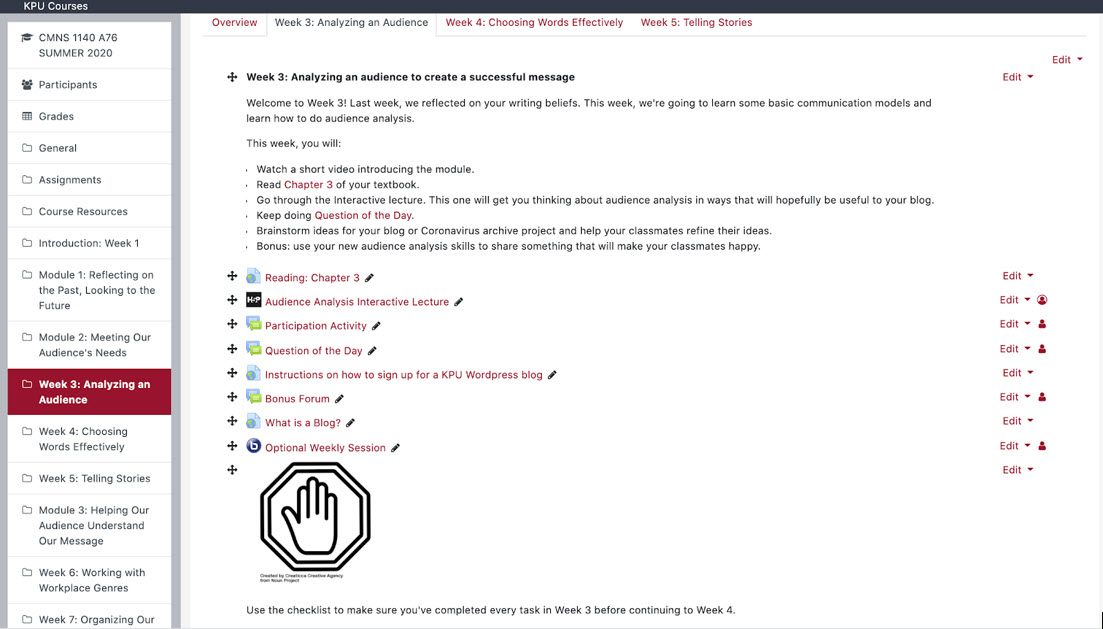About this course and resources
Thank you for your interest in our Business Communication OOC. This course is a first-year business communication course. This resource contains:
- A course plan for instructors, which breaks the course into modules
- Weekly lesson plans for students with notes for instructors (available for download in each week’s chapter in this book)
- A suggested assignment package
- A sample course presentation (syllabus)
- Weekly readings, based on the OER textbook Business Writing For Everyone.
- Interactive asynchronous lectures (available for download in each week’s chapter in this book), which invite students to reflect on the readings through short activities. The H5P versions of these lectures include quizzes and other interactive content, but we have also included Powerpoint versions of the interactive lectures for those whose Learning Management Systems don’t support H5P. Audio recordings of these interactive lectures are also provided. The PowerPoint slides and audio recording files can be downloaded from within each week’s chapter in this book.
- Participation activities (including supplementary resources). These resources are listed in the appendix of this book. Though these resources are meant for online teaching, we have also included alternative activities for face-to-face learning. Many are based on our Student Engagement Activities for Business Communications OER instructor resource.
Resources for business communications OOC by Arley Cruthers, Melissa Ashman, John Grant, Seanna Takacs, and Peg Fong is licensed under a Creative Commons Attribution 4.0 International License, except where otherwise noted. The files available for download in this book are similarly licensed, except where otherwise noted.
About This Course
We have taken a process-oriented approach to this course that focuses less on genre and more on the decisions that business communicators make. We want students to reflect on their own writing beliefs, values and experiences, then apply these learnings to a business communication context. We have intentionally avoided relying heavily on video content, since many of our students do not have stable Internet access.
This course can be used as a “course in a box” that you can plug into your learning management system and use. You might choose to customize it by developing your own module overview videos and videos to explain the assignments. We also encourage you to personalize this content by adding your own graphics and visuals.
However, we also have tried to build in flexibility so that you can take bits and pieces that work for you and remix them, since everything in this OOC has a CC-BY license.
Using This Resource
In the weekly lesson plans you will find:
- text or content for students appears in black font. Some of this content can be pasted into forums or other activities, and some can appear as a label in the learning management system. Below, you will see a screenshot of how one instructor has set up this content in her LMS.

- notes for the instructors are shown using bold green font. These notes are also offset with a heading of “Instructor notes” and an icon that looks like this:

In the course plan, assignment deadlines are highlighted in yellow.
Throughout the course, there are opportunities for the instructor to customize and personalize the content, such as through creating and providing personalized module introduction videos and personal stories.
A Note About Blogging
This course is geared around a blogging assignment. Each student will develop their own blog throughout the semester. We chose to have students blog for the following reasons:
- Blogging requires many of the skills students focus on over the course of the semester: considering an audience’s needs, making style and tone choices, using visuals, integrating sources, doing research and organizing information etc.
- Blogging gives students an audience outside of the class.
- Blogging allows students to pursue their own interests while still achieving the course learning outcomes. Because students choose the topic, many will spend more time and attention to their blogs than they might do for an assignment that is more focused on a business context.
- Blogging is process-oriented. Students are encouraged to make several blog entries and then hand in the most successful ones.
In the original version of this course, students developed and maintained their own blog. However, other instructors have modified the assignment so that students keep a class blog about one topic, or work in small groups to create and maintain a blog.
It is also possible to use this OOC without assigning a blogging project. In that case, you may want to swap out blogging examples from the interactive lectures.

